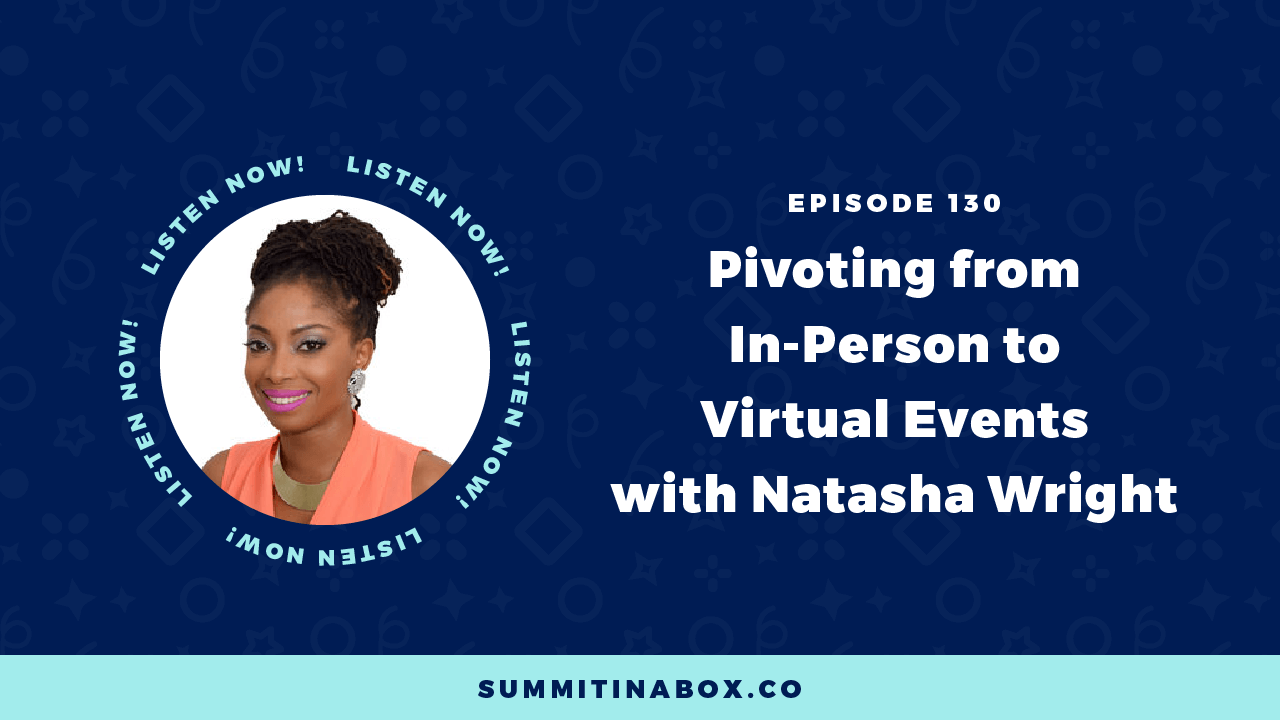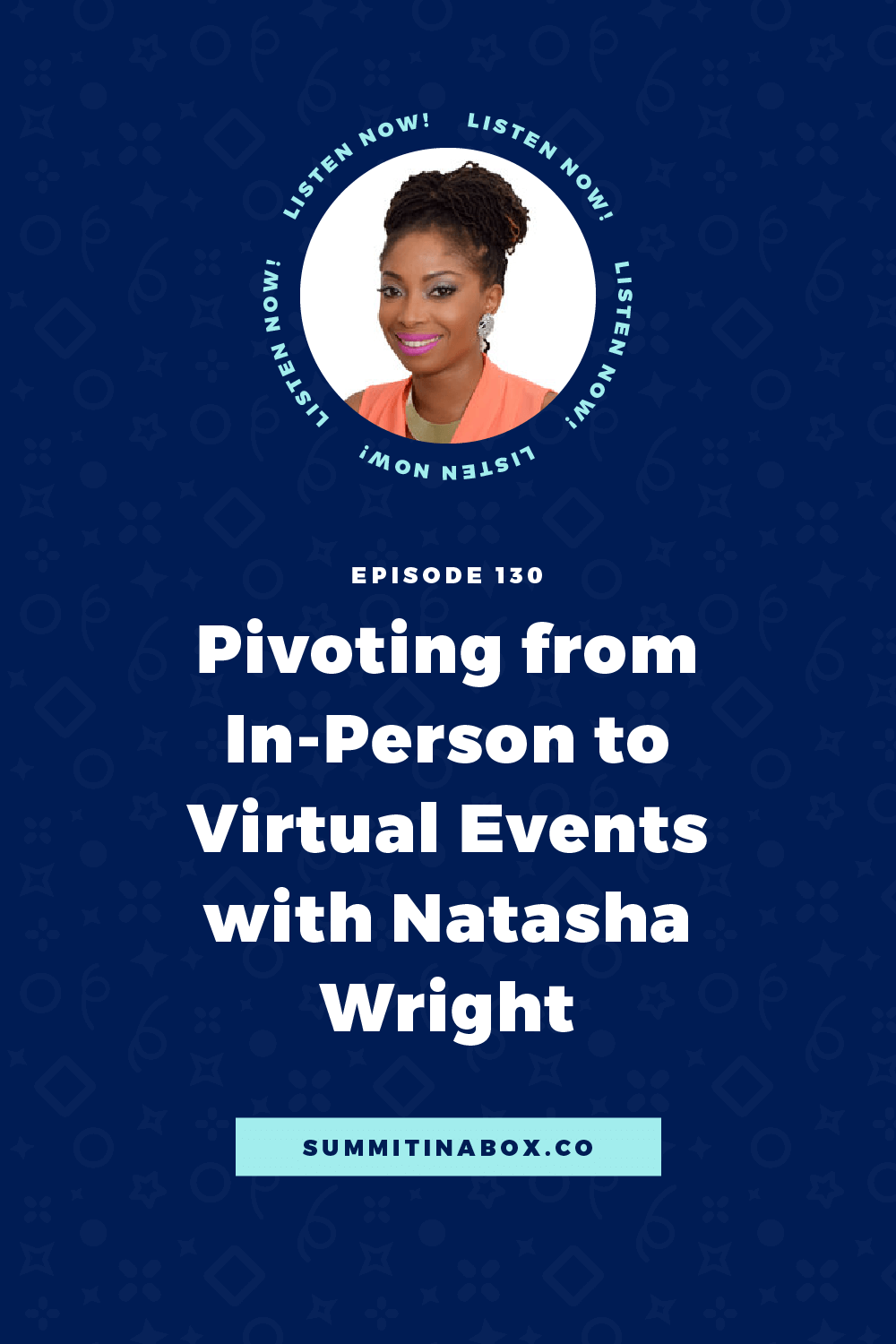Pivoting from In-Person to Virtual Events with Natasha Wright


If you've run in-person events and are ready to go virtual, there can be a bit of a learning curve.
You might have a lot of questions: What's different between the two? How do I keep attendees engaged? Can I still reach my goals?
Today, Natasha Wright is breaking down how to:
- hit your in-person event goals with a virtual event.
- understand the key steps in switching from in-person to virtual.
- create engagement that so many virtual events are missing.
- know which roadblocks to look out for when you're making the switch.
I'll let Natasha take it from here!
Pivoting from In-Person to Virtual Events
Although we're at a point where in-person events can start happening again, some summit hosts who have put on in-person events still want to widen their reach with a virtual event.
Natasha’s Point of View
Right as the world began to shut down because of COVID, I was planning the Community Health Summit, which was an in-person event. When we realized we wouldn't be able to make it happen, we still wanted to engage those who had registered, so we started doing live streams to keep the conversation going. And that's where my virtual event experience began.
After that, people asked me for help with their live streams and productions. It wasn’t an easy transition, but it was gradual. I started by checking out virtual event platforms and taught myself how to produce virtual events.
The biggest learning curve was the technology. Previously, the only piece I was doing digitally was managing my social media accounts and updating my website. I didn’t know about the different technologies out there to engage people or the different platforms for hosting an event.
Natasha’s Tech Recommendations
After trying various tech platforms and applications, I have a few favorites:
- Streamyard – I love you’re able to brand your live stream, create something more dynamic, and be able to live stream to multiple places simultaneously. (Affiliate link)
- Hopin – I love this platform for event management, but sometimes when I’m working with clients, it doesn’t necessarily work for them in terms of what they want to do, but it’s the one I start with.
- Miro – Miro is a fast, free, and simple-to-use online whiteboard built to help you collaborate with others anytime, anywhere.
Setting Goals for Your Event
The goals that summit hosts have in mind for in-person events can transfer to the virtual space too. However, you need to design the event differently. It's not going to be the exact same thing that you'd do in person.
Set goals that make sense for the virtual space you are in.
- Clarify Your Goals - Hosting an event is a marketing opportunity and marketing tool that you can use within your business. A lot of times people think about how much money they can make. Yes, there's an opportunity for you to make money, but it's also an opportunity for you to market your business as well.
- Marketing - One of the goals that summit hosts might have is marketing. It’s a way to build your brand and authority. It’s a great opportunity to stand out and build that know-like-trust factor.
- Generate Leads - You're generating leads by hosting an event, but by being a virtual event you’ll have a much larger reach than you would have had with an in-person event since travel isn't an issue.
- Social Media - Hosting a virtual event is a great way for you to amplify your brand on social media. If people attend your event and have an amazing experience, they're going to want to share it with their following as well.
Steps to Switch from an In-Person to Virtual
1. Allow for a longer timeline than you'd expect
Many hosts diving into virtual events for the first time think that it will be easier than an in-person event and only need a short timeline. However, that isn't the case. Continue to allow for a 3-4 month timeline for your summit prep.
2. Research the different platforms
Research the different platforms available to accommodate what you want for your event. The process is similar to what you'd do to visit different venues in-person and see if they work in terms of capacity, your pricing, etc.
Find a platform that can not only provide the services you need, but choose one that’s easy for speakers and attendees to use.
3. Communicate with Speakers
If you’re using a new platform, record a video to show speakers how to use the platform, and include it in any emails you send them. Make it as easy as you can for a better experience.
4. Communicate with Attendees
Also, communicate with your attendees about what steps they should take beyond the summit. The virtual event space isn’t just an opportunity for you to share the content of the event, but an opportunity for you to continue to share your related services or products.
Potential Roadblocks
There are a few potential roadblocks you might come across when shifting to a virtual event.
The first is engagement. An important piece of your summit’s success is engaged attendees. To keep attendees engaged, add in elements of engagement such as a DJ during breaks or collaborative time for attendees to get together and do some co-working or networking.
Another potential roadblock is how to monetize their virtual summit. These summits are marketing opportunities. If you look at it like your spending marketing dollars, you’re investing in a marketing facet of your business. If you plan your backend to sell your program or course, you’re going to be able to continue to nurture attendees once the event is over.
Natasha’s Biggest Takeaway
The biggest things I want you to take away from this include...
- Have ample time - Plan your summit prep timeline and steps with plenty of time to allow for learning curves.
- Think about the intention for your event - Consider how you're going to achieve the transformation you want for your attendees.
- Ask for help – As small business owners, we feel like we can do it all, but it’s okay to ask for help for things outside your zone of expertise.
About Natasha
 Natasha Wright is a Certified Meeting & Event Manager (CMP). She supports businesses and organizations with producing hybrid events, virtual events, and live streams. She has planned, managed, and marketed several in-person and virtual events in the areas of health, business, and community engagement. Her goal is to support change agents with bringing their visions to life and build their brands through highly engaging and memorable events.
Natasha Wright is a Certified Meeting & Event Manager (CMP). She supports businesses and organizations with producing hybrid events, virtual events, and live streams. She has planned, managed, and marketed several in-person and virtual events in the areas of health, business, and community engagement. Her goal is to support change agents with bringing their visions to life and build their brands through highly engaging and memorable events.
Website | eBook Virtual Event Engagement Ideas
Resources
- StreamYard
- Hopin
- Miro
- Episode 53: How to Craft an Engaging Virtual Summit
- Episode 29: How Long Does It Take To Plan An Online Summit?
- Summit Host Hangout Facebook group
Pin it for later!



5-Minute Virtual Summit Roadmap
The 5-Minute Summit Roadmap leads you through the 7 essential questions that will guide the rest of your summit planning process and help you finally start making meaningful progress toward a profitable event.

